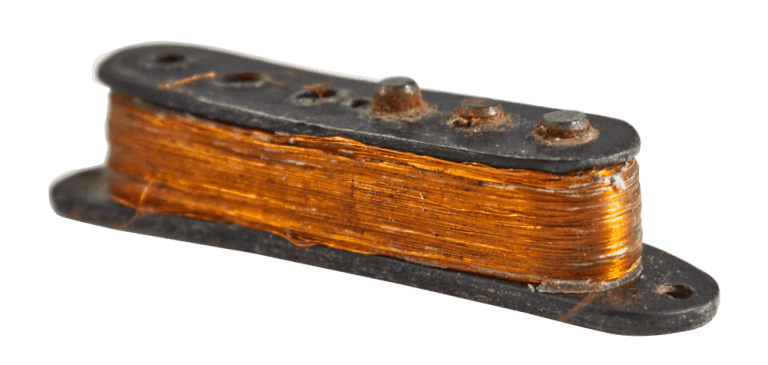How Does Coil-Splitting Work?
Coil Splitting is a simple, usable way to add another dimension of tone to your guitar. You can essentially double your tone, with a flip (or pull) of a switch. You […]


Wax Potting is an essential part of the pickup-making process. At Fralin Pickups, it is the last step of the manufacturing process before it goes to the shipping room. It is a delicate and vital technique that requires a good deal of attention to the details.
We get asked all the time about Wax Potting. What is it? Is it necessary? How does it work? Let’s clear up a few things with this short-and-sweet article.
On its surface, Wax Potting is a simple series of actions. However, it is one of the most crucial parts of the manufacturing process. Wax Potting is the process of immersing guitar and bass pickups in wax. The method solves two main problems: 1.) It prevents Microphonics, and 2.) It protects the pickup for many years.
What are Microphonics? Microphonics are the byproduct of vibrating metal. Pickups, ironically, are designed to pick up vibrating metal (strings), but particular vibrations are unwanted. These unwanted vibrations can transform into an electric signal, and sent through to your amp. Guitar Pickups tend to produce Microphonics, especially under high gain. Pickup materials include metal covers, baseplates, screws, hardware – not to mention the coil itself. Any physical vibration from these elements can cause Microphonics.
High Gain situations tend to amplify microphonics. Putting your guitar’s signal through a distortion pedal amplifies your signal until it breaks up and distorts. Because of this amplification, microphonics are more common.
Wax Potting remedies this problem by coating the metal parts in wax. The wax, when dried, dampens and prevents any vibration coming from the coil or pickup parts.

Corrosion from moisture is the main threat to the health of a guitar or bass pickup. The coil, made from insulated copper, is very delicate. If the insulation and copper have been worn away, your signal can experience high resistance or a broken circuit.
Moisture from humidity, sweat, and beer are the reason for the bulk of our rewinds. Look at the image above: moisture most likely entered the coil around the magnets and killed the pickup from the inside. By potting the pickup effectively in wax, we ‘seal’ the pickup and prevent direct and indirect moisture from penetrating the coil.
Strat Pickups from the ’70s were dipped in lacquer – a process that worked for years. However, as the lacquer aged, it flaked off and allowed moisture to enter the coil. Furthermore, lacquer does not penetrate the coil – it merely coats the surface. Because of this, Paraffin Wax is our go-to preservative. It has wonderful shelf-life.
At Fralin Pickups, Lindy carefully selected our wax to provide the best protection and lowest tonal impact as possible. The wax we use has a low melting temperature, a low dielectric constant, and doesn’t shrink when cooled.
Having a Low Melting Temperature is essential. Having wax at a high temperature can warp plastic parts, and damage the pickup. The wax we selected also has a low dielectric constant: it has a minimum impact on the tone of the guitar pickup.
Some manufacturers did not pot their pickups at the factory. Some of those models are very desirable! Original PAF pickups sound lively and responsive. However, we’ve seen a fair amount of these pickups in the shop for a rewind. We believe that our wax not only protects and preserves but also sounds the best as well. Lindy has tried a few different types of wax but has found that our current wax has the best effects on quality and the lowest impact on our tone!
What do you think about Wax Potting? Leave us a comment and start a discussion below!
21 Comments For This Post
Want to chime in to the conversation? Please do so! Please respect others.
Sorry… my earlier post should have read, “…Eddy Van Halen”
In an interview with Eddy Van Haley, he implies that waxing pots was his original idea. Is that true, and if so, should he not receive credit when describing the importance of the whole process?
While Eddie Van Halen was one of the first users of wax-potted pickups, this article states it was actually Seymour Duncan who devised the idea.
Hi, I just received some P90s from Fralin and even though they are potted, I get microphonic feedback from the bridge pup when overdriven. They are -5% underwound and in a semi hollow body (Epi Wildkat). Does it just need a little more wax?
I’ve potted my very microphonic Gibson mini buckers with great success so I know it can work very well.
Hey Tom, yes – they should just need additional potting. If they are microphonic, we can re-pot them for you, as that’s a warranty issue. As always, if you want to DIY, that’s fine as well! Just let us know.
I’m thinking of removing the covers on my Gibson Les Paul pick-ups. Not sure if they’re waxed, but if they are and I remove it, will it lead to excessive feedback?
Thanks so much for this article. I am about to receive a guitar with non potted pickups and was curious about the whole potting situation. If they do squeal too much does it make sense to pot them or to just purchase new potted pickups?
BTW- I love the both your pure PAFs and Modern PAFs.
If you like the tone of the pickups, it makes sense to just get them potted. We do it for $46 out the door.
Hi Tyler
I have a question regarding melting the wax.
Which is the proper way to melt the wax?
Melting the wax just by itself with nothing else or with a water bath?
Can you reply back to me soon please?
Thanks
Corey
Hey Corey, the best way is to just melt the wax by itself – not with water. You can use a crock pot.
Is waxing a pickup something that an enthusiastic amateur can do at home?
What should I specifically ask for when looking for paraffin wax?
Any hints to doing this at home?
You can absolutely do this at home. Some home enthusiasts use a crock pot to heat up the wax. We recommend using unscented paraffin wax from a reputable candle wax company. Aim for about 140 or 150 degrees fahrenheit.
Y’all have been talking about waxing and that’s cool and also what brought me but if it ok ive got a question or two about over winding from what I’ve read overwinding makes the pickup have a darker or muddier sound witch is great to know but I also wanted to know how you could recognize one if it came in a used guitar that you had no history on I mean could you use an ohm meter and if so what would the ohms read higher than stock or lower witch I would think higher but how much and if I’m missing any other ways of being able to tell what are they
Thank you
Hey Steven, without a resistance reading and the pickup’s manufacturer’s specifications, it would be impossible to tell if a pickup is underwound or overwound. If you had a spec sheet and the pickup said “7K”, and you took a reading of your pickup and it came out to be 7.5K, you could reasonably infer that your pickup is overwound from the original manufacturer’s specs.
I am completely new to messing with my pickups, other than adjusting height or poles. I have a guitar with zebras and want to put raw nickel covers on. If you pot my covers beforehand, what is the process that I need to follow to install the covers with wax? If it’s complicated I may not worry about the waxing of the covers.
Hey John, check this article here on that subject!
Hey Tyler,
Small correction.
“The wax, when dried, dampens and prevents any vibration coming from the coil or pickup parts.”
The correct term is to DAMP, not DAMPEN.
You DAMP the vibrations.
Whereas, to DAMPEN, means to MOISTEN, to WET something.
(Actually, what you’re trying to AVOID, here!)
So, in ACOUSTICS, you DAMP. In DIAPERS, you DAMPEN.
But, you probably already knew this… it’s a common error.
(Not as bad as the popular “HONING IN” on something, though! Probably done with “Honing” Pidgins!?!)
In any case, Great Blogs, Tyler, BTW.
I could go either way. I tend to think the non potted pups “breathe” more and i enjoy the harmonics to an extend. Like a lot of us though i want something different sometimes and enjoy a potted pup. My unpotted Seth Lover sounds like brown sugar coated butter but i have other potted pups that may not sound as “open” but are still very smooth or creamy. Obviously i like options lol.
Personally, I find the sound from un-potted pickups to have more mojo.
The melt point of paraffin is around 99 deg. F. Has Lindy ever had an issue with wax on pickups melting?
Wax potting with a preferred type of wax is what Lindy uses. There are reasons why he is considered one of the top experts on pickups in the USA. Whether we know much about ‘wax potting’ beyond stopping ‘squeal’ … if Lindy Fralin considers it important, then it is.